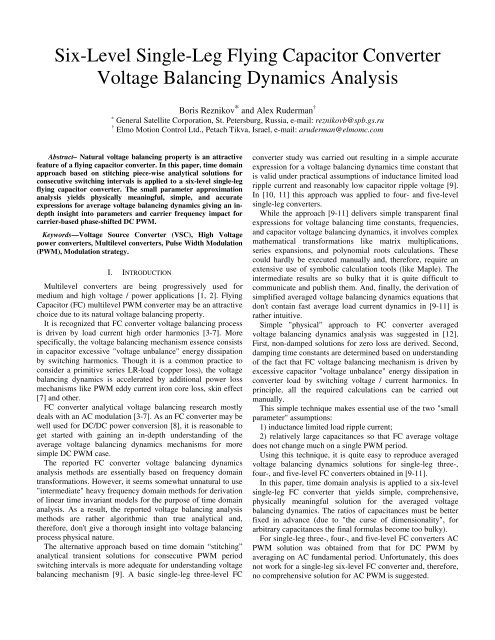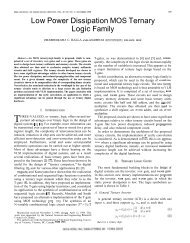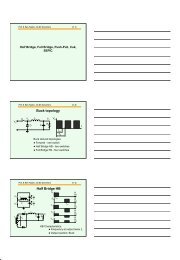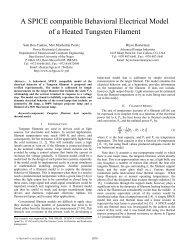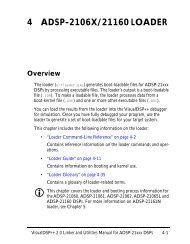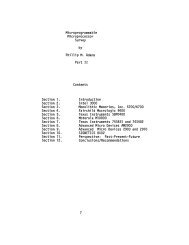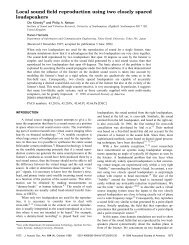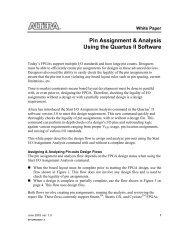Six-Level Single-Leg Flying Capacitor Converter Voltage Balancing ...
Six-Level Single-Leg Flying Capacitor Converter Voltage Balancing ...
Six-Level Single-Leg Flying Capacitor Converter Voltage Balancing ...
Create successful ePaper yourself
Turn your PDF publications into a flip-book with our unique Google optimized e-Paper software.
<strong>Six</strong>-<strong>Level</strong> <strong>Single</strong>-<strong>Leg</strong> <strong>Flying</strong> <strong>Capacitor</strong> <strong>Converter</strong><br />
<strong>Voltage</strong> <strong>Balancing</strong> Dynamics Analysis<br />
Boris Reznikov * and Alex Ruderman †<br />
* General Satellite Corporation, St. Petersburg, Russia, e-mail: reznikovb@spb.gs.ru<br />
† Elmo Motion Control Ltd., Petach Tikva, Israel, e-mail: aruderman@elmomc.com<br />
Abstract– Natural voltage balancing property is an attractive<br />
feature of a flying capacitor converter. In this paper, time domain<br />
approach based on stitching piece-wise analytical solutions for<br />
consecutive switching intervals is applied to a six-level single-leg<br />
flying capacitor converter. The small parameter approximation<br />
analysis yields physically meaningful, simple, and accurate<br />
expressions for average voltage balancing dynamics giving an indepth<br />
insight into parameters and carrier frequency impact for<br />
carrier-based phase-shifted DC PWM.<br />
Keywords—<strong>Voltage</strong> Source <strong>Converter</strong> (VSC), High <strong>Voltage</strong><br />
power converters, Multilevel converters, Pulse Width Modulation<br />
(PWM), Modulation strategy.<br />
I. INTRODUCTION<br />
Multilevel converters are being progressively used for<br />
medium and high voltage / power applications [1, 2]. <strong>Flying</strong><br />
<strong>Capacitor</strong> (FC) multilevel PWM converter may be an attractive<br />
choice due to its natural voltage balancing property.<br />
It is recognized that FC converter voltage balancing process<br />
is driven by load current high order harmonics [3-7]. More<br />
specifically, the voltage balancing mechanism essence consists<br />
in capacitor excessive "voltage unbalance" energy dissipation<br />
by switching harmonics. Though it is a common practice to<br />
consider a primitive series LR-load (copper loss), the voltage<br />
balancing dynamics is accelerated by additional power loss<br />
mechanisms like PWM eddy current iron core loss, skin effect<br />
[7] and other.<br />
FC converter analytical voltage balancing research mostly<br />
deals with an AC modulation [3-7]. As an FC converter may be<br />
well used for DC/DC power conversion [8], it is reasonable to<br />
get started with gaining an in-depth understanding of the<br />
average voltage balancing dynamics mechanisms for more<br />
simple DC PWM case.<br />
The reported FC converter voltage balancing dynamics<br />
analysis methods are essentially based on frequency domain<br />
transformations. However, it seems somewhat unnatural to use<br />
"intermediate" heavy frequency domain methods for derivation<br />
of linear time invariant models for the purpose of time domain<br />
analysis. As a result, the reported voltage balancing analysis<br />
methods are rather algorithmic than true analytical and,<br />
therefore, don't give a thorough insight into voltage balancing<br />
process physical nature.<br />
The alternative approach based on time domain “stitching”<br />
analytical transient solutions for consecutive PWM period<br />
switching intervals is more adequate for understanding voltage<br />
balancing mechanism [9]. A basic single-leg three-level FC<br />
converter study was carried out resulting in a simple accurate<br />
expression for a voltage balancing dynamics time constant that<br />
is valid under practical assumptions of inductance limited load<br />
ripple current and reasonably low capacitor ripple voltage [9].<br />
In [10, 11] this approach was applied to four- and five-level<br />
single-leg converters.<br />
While the approach [9-11] delivers simple transparent final<br />
expressions for voltage balancing time constants, frequencies,<br />
and capacitor voltage balancing dynamics, it involves complex<br />
mathematical transformations like matrix multiplications,<br />
series expansions, and polynomial roots calculations. These<br />
could hardly be executed manually and, therefore, require an<br />
extensive use of symbolic calculation tools (like Maple). The<br />
intermediate results are so bulky that it is quite difficult to<br />
communicate and publish them. And, finally, the derivation of<br />
simplified averaged voltage balancing dynamics equations that<br />
don't contain fast average load current dynamics in [9-11] is<br />
rather intuitive.<br />
Simple "physical" approach to FC converter averaged<br />
voltage balancing dynamics analysis was suggested in [12].<br />
First, non-damped solutions for zero loss are derived. Second,<br />
damping time constants are determined based on understanding<br />
of the fact that FC voltage balancing mechanism is driven by<br />
excessive capacitor "voltage unbalance" energy dissipation in<br />
converter load by switching voltage / current harmonics. In<br />
principle, all the required calculations can be carried out<br />
manually.<br />
This simple technique makes essential use of the two "small<br />
parameter" assumptions:<br />
1) inductance limited load ripple current;<br />
2) relatively large capacitances so that FC average voltage<br />
does not change much on a single PWM period.<br />
Using this technique, it is quite easy to reproduce averaged<br />
voltage balancing dynamics solutions for single-leg three-,<br />
four-, and five-level FC converters obtained in [9-11].<br />
In this paper, time domain analysis is applied to a six-level<br />
single-leg FC converter that yields simple, comprehensive,<br />
physically meaningful solution for the averaged voltage<br />
balancing dynamics. The ratios of capacitances must be better<br />
fixed in advance (due to "the curse of dimensionality", for<br />
arbitrary capacitances the final formulas become too bulky).<br />
For single-leg three-, four-, and five-level FC converters AC<br />
PWM solution was obtained from that for DC PWM by<br />
averaging on AC fundamental period. Unfortunately, this does<br />
not work for a single-leg six-level FC converter and, therefore,<br />
no comprehensive solution for AC PWM is suggested.
VDC/<br />
2<br />
VDC/<br />
2<br />
C C 4 3 C 2 C 1<br />
vC<br />
4<br />
vC3<br />
vC<br />
2<br />
vC1<br />
II. SINGLE-LEG SIX-LEVEL FC CONVERTER TOPOLOGY AND<br />
MODULATION STRATEGY<br />
<strong>Single</strong>-leg six-level FC converter topology is shown in Fig.1.<br />
Consider positive normalized voltage commands 0
VDC<br />
/ 2<br />
VDC<br />
/ 2<br />
VDC<br />
/ 2<br />
C4<br />
C2<br />
L R<br />
∆ t = ( D − 3/<br />
5)<br />
T / 2.<br />
(3)<br />
6 PWM<br />
i<br />
L R<br />
C C L R<br />
4<br />
C2 3<br />
1<br />
i<br />
i<br />
VDC<br />
/ 2<br />
Modulation strategy for 1/5
where<br />
t = ∆t<br />
;<br />
t<br />
1<br />
2<br />
.......... .......... .......... .......... .......... ......<br />
t<br />
t<br />
10<br />
11<br />
= T<br />
1<br />
= ∆t<br />
+ ∆t<br />
;<br />
1<br />
1<br />
6<br />
= ∆t<br />
+ ∆t<br />
+ ∆t<br />
+ ∆t<br />
+ ∆t<br />
+ 5∆t<br />
= T<br />
PWM<br />
2<br />
+ ∆t<br />
;<br />
1<br />
3<br />
.......... .......... .......... .......... .......... ........<br />
4<br />
5<br />
6<br />
PWM<br />
Example 1. Consider single-leg six-level FC converter:<br />
= 50V<br />
; R = 1Ohm<br />
; L = 0.<br />
5mH<br />
; C C = C = C =<br />
V DC<br />
T PWM<br />
= C = 400uF<br />
; = 560us<br />
( 1 . 8kHz<br />
).<br />
1 = 2 3 4<br />
;<br />
(10)<br />
<strong>Converter</strong> dynamics switched simulation results obtained by<br />
programming formulas (9), (10) are presented in Fig.8.<br />
The average load current and capacitor voltages converge to<br />
i(<br />
∞)<br />
= V D /( 2R);<br />
v ( ∞)<br />
= V<br />
1<br />
v ( ∞)<br />
= 3V<br />
3<br />
DC<br />
DC<br />
/ 5;<br />
DC<br />
/ 5;<br />
v ( ∞)<br />
= 2V<br />
2<br />
v ( ∞)<br />
= 4V<br />
for any set of initial conditions.<br />
Current and <strong>Voltage</strong>s<br />
Current and <strong>Voltage</strong>s<br />
60<br />
50<br />
40<br />
30<br />
20<br />
10<br />
3<br />
DC<br />
DC<br />
/ 5;<br />
/ 5<br />
6-<strong>Level</strong> FC <strong>Converter</strong> Load Current and <strong>Capacitor</strong> <strong>Voltage</strong>s (D=0.1)<br />
(11)<br />
0<br />
0 0.05 0.1 0.15 0.2 0.25 0.3 0.35 0.4<br />
-10<br />
-20<br />
60<br />
50<br />
40<br />
30<br />
20<br />
10<br />
-10<br />
-20<br />
Load Current V1 <strong>Capacitor</strong> <strong>Voltage</strong> V2 <strong>Capacitor</strong> <strong>Voltage</strong> V3 <strong>Capacitor</strong> <strong>Voltage</strong> V4 <strong>Capacitor</strong> <strong>Voltage</strong><br />
Time, s<br />
a<br />
6-<strong>Level</strong> FC <strong>Converter</strong> Load Current and <strong>Capacitor</strong> <strong>Voltage</strong>s (D=0.434)<br />
Load Current V1 <strong>Capacitor</strong> <strong>Voltage</strong> V2 <strong>Capacitor</strong> <strong>Voltage</strong> V3 <strong>Capacitor</strong> <strong>Voltage</strong> V4 <strong>Capacitor</strong> <strong>Voltage</strong><br />
0<br />
0 0.05 0.1 0.15 0.2 0.25 0.3 0.35 0.4<br />
Time, s<br />
b<br />
Fig. 8. FC converter current and capacitor voltages switched simulation for<br />
different voltage commands and initial conditions: a - D=0.1; b - D=0.434<br />
Fig.8 shows that load current settles very fast. <strong>Capacitor</strong><br />
voltages response is comprised of high frequency component<br />
with relatively strong damping and dominating low frequency<br />
component with relatively weak damping.<br />
In the examples throughout this paper, the switches are<br />
assumed ideal with reverse voltage blocking capability. This is<br />
not correct for the real life switches with anti-parallel diodes.<br />
As the natural voltage balance condition v 1 < v2<br />
< v3<br />
< v4<br />
tends to be violated due to unbalanced initial conditions and<br />
oscillating response, the anti-parallel diodes come into play<br />
and the linear model is no more valid due to non-linear<br />
clamping effects. However, if the capacitor voltages are<br />
balanced and the DC bus disturbance is moderate, then the<br />
above condition is never violated and the linear model is valid<br />
for the real life switches [7].<br />
IV. FC CONVERTER VOLTAGE BALANCING DYNAMICS FOR DC<br />
MODULATION<br />
Suppose that the interval 1 initial conditions are substituted,<br />
along with the interval 1 duration, into the interval 1 dynamic<br />
solution. This gives initial conditions for the next interval 6. By<br />
substituting them with the interval 6 duration into the interval 6<br />
dynamic solution, initial conditions for the interval 2 are<br />
obtained. Carrying out the same procedure for the rest of PWM<br />
subintervals 2-6-3-6-4-6-5-6 completes a PWM period and a<br />
linear difference vector equation for 3/5
Using "on average" derivatives approximation<br />
di i(<br />
t + TPWM<br />
) − i(<br />
t)<br />
dv v(<br />
t + TPWM<br />
) − v(<br />
t)<br />
≈ ; ≈<br />
, (15)<br />
dt T<br />
dt T<br />
PWM<br />
PWM<br />
from (12) the FC converter “averaged” voltage balancing<br />
dynamics continuous time model in the form of differential<br />
equation becomes<br />
dX 1<br />
1<br />
= ( A(<br />
D)<br />
− I ) X + B(<br />
D)<br />
VDC<br />
/ 2 . (16)<br />
dt T<br />
T<br />
PWM<br />
PWM<br />
An accurate solution and switched simulation will show five<br />
times switching frequency ripples in load current and capacitor<br />
voltages that are filtered out in the averaged models (12), (16).<br />
FC converter averaged voltage balancing dynamics analysis<br />
methodology [9-11] comprises the following steps. First, we<br />
obtain the characteristic polynomial of matrix A(D) (13)<br />
5 4 3 2<br />
P ( λ ) = λ + b λ + b λ + b λ + b λ + b . (17)<br />
4<br />
3<br />
2<br />
As the matrix A(D) is about multiplying 10 5x5 matrices,<br />
this could hardly be done manually and requires an assistance<br />
of some symbolic calculations tool.<br />
Second, each coefficient of (17) is expanded into power<br />
series of a small parameter (multiplied by some function of D)<br />
β ω<br />
, (18)<br />
T<br />
= 1 PWM<br />
4L / R as well though, most likely, this is not a practical<br />
FC converter case.<br />
The selection of the series expansion maximum power for<br />
the coefficients (17) is dictated by the accuracy considerations<br />
for the polynomial roots with a modulus close to unity.<br />
Third, the roots of (17) with the series expanded coefficients<br />
are found analytically in the form of series expansion. For the<br />
small parameter approximation (18), it may be shown that<br />
there is always one real root and two pairs of complex<br />
conjugate roots.<br />
The above calculations must be performed on separate for<br />
3/5
Frequency, p.u.<br />
Time Constant, p.u..<br />
6-<strong>Level</strong> <strong>Single</strong>-<strong>Leg</strong> FC <strong>Converter</strong> Normalized Frequencies<br />
15<br />
14<br />
13<br />
12<br />
11<br />
10<br />
9<br />
8<br />
7<br />
6<br />
5<br />
4<br />
3<br />
2<br />
1<br />
0<br />
0 0.1 0.2 0.3 0.4 0.5 0.6 0.7 0.8 0.9 1<br />
1<br />
0.9<br />
0.8<br />
0.7<br />
0.6<br />
0.5<br />
0.4<br />
0.3<br />
0.2<br />
0.1<br />
While the high frequency is decreasing monotonically in D,<br />
the low frequency equals zero for D=0.145 and has maximum<br />
for D=0.434 (Fig.8,b).<br />
The high frequency related time constant is increasing<br />
monotonically while the low frequency time constant has<br />
minimum for D=0.5. Note relatively poor voltage balancing<br />
rate for D=0 and small D. This may hopefully be improved by<br />
better modulation strategy without compromising optimal<br />
voltage quality (see discussion in Section II).<br />
V. VOLTAGE BALANCING DYNAMICS SOLUTIONS<br />
Simple physical approach to FC converter averaged voltage<br />
balancing dynamics analysis [12] makes it possible to obtain<br />
non-damped linear time-invariant differential equations zero<br />
load resistance and zero DC bus voltage<br />
'<br />
X ( t)<br />
= A(<br />
D)<br />
X ( t),<br />
X ( 0)<br />
= X 0;<br />
(28)<br />
T<br />
X ( t)<br />
= v ( t)<br />
v ( t)<br />
v ( t)<br />
v ( t)<br />
[ ] .<br />
1<br />
2<br />
Normalized <strong>Voltage</strong> Command D, p.u.<br />
a<br />
6-<strong>Level</strong> <strong>Single</strong>-<strong>Leg</strong> FC <strong>Converter</strong> Normalized Time<br />
Constants<br />
0<br />
0 0.1 0.2 0.3 0.4 0.5 0.6 0.7 0.8 0.9 1<br />
Normalized <strong>Voltage</strong> Command D, p.u.<br />
b<br />
Fig. 9. FC converter voltage balancing dynamics frequencies (a) and time<br />
constants (b) for equal capacitances<br />
3<br />
Calculation of state-space matrices for different voltage<br />
command intervals yields<br />
4<br />
for 3/5
for damping time constants (23), (25), (27) and non-zero DC<br />
bus voltage.<br />
To incorporate a non-zero DC bus voltage (forced solution)<br />
into (32), one has to add the balanced capacitor voltage values<br />
(1) and to replace the initial conditions according to<br />
v ( 0)<br />
→ v ( 0)<br />
−V<br />
/ 5;<br />
v ( 0)<br />
→ v ( 0)<br />
− 2V<br />
/ 5;<br />
v<br />
1<br />
3<br />
( 0)<br />
1<br />
→ v<br />
3<br />
DC<br />
( 0)<br />
− 3V<br />
DC<br />
/ 5;<br />
2<br />
v<br />
4<br />
( 0)<br />
2<br />
→ v<br />
4<br />
DC<br />
( 0)<br />
− 4V<br />
DC<br />
/ 5.<br />
(34)<br />
The final expressions are a little bit bulky and, therefore, are<br />
not presented here. Their comparison with accurate switched<br />
simulation results (Fig.10) shows good practical accuracy of<br />
approximate averaged voltage balancing dynamics solutions.<br />
Due to the carrier signals order C1; C2; C3; C4; C5 phaseshifted<br />
PWM strategy (Fig.2, 4, 6) may be referred to as "lead"<br />
one. Alternatively, PWM with reverse order C5; C4; C3; C2;<br />
C1 may be considered as "lag" strategy.<br />
As may be easily observed, the lag PWM strategy generates<br />
inverse switching states order with respect to the lead one. Lag<br />
PWM voltage balancing dynamics solution may be formally<br />
obtained from that for lead modulation by changing to the<br />
opposite the signs of sinusoidal terms in (33) [10, 11].<br />
VI. FC CONVERTER VOLTAGE BALANCING DYNAMICS<br />
ANALYSIS FOR AC MODULATION<br />
For AC PWM, the FC dynamics models become linear timevariable.<br />
For three-, four-, and five-level single-leg converters<br />
voltage balancing dynamics solutions for AC PWM were<br />
obtained from those for DC PWM by averaging oscillation<br />
frequencies and inverse time constants on AC fundamental<br />
period [9-11]. An explanation may be that this is possible due<br />
to "scalar" type dependence of non-damped equations on D<br />
similar to (28), (29). In six-level FC converter case, the<br />
situation is more complicated because for 0
Fig.12, c confirms that for modulation index M=0.2 the low<br />
oscillation frequency is very close to zero.<br />
The authors have to admit that so far they don't have a<br />
comprehensive solution for AC PWM time constants and<br />
voltage balancing dynamics.<br />
VII. CONCLUSION<br />
This paper investigated into natural voltage balancing<br />
dynamics for a six-level single-leg FC converter with carrier-<br />
Current and <strong>Voltage</strong>s<br />
Current and <strong>Voltage</strong>s<br />
Current and <strong>Voltage</strong>s<br />
60<br />
50<br />
40<br />
30<br />
20<br />
10<br />
-10<br />
6-<strong>Level</strong> FC <strong>Converter</strong> Load Current and <strong>Capacitor</strong> <strong>Voltage</strong>s (M=0.1;<br />
f=25Hz)<br />
0<br />
0 0.05 0.1 0.15 0.2 0.25 0.3 0.35 0.4<br />
60<br />
50<br />
40<br />
30<br />
20<br />
10<br />
-10<br />
Load Current V1 <strong>Capacitor</strong> <strong>Voltage</strong> V2 <strong>Capacitor</strong> <strong>Voltage</strong> V3 <strong>Capacitor</strong> <strong>Voltage</strong> V4 <strong>Capacitor</strong> <strong>Voltage</strong><br />
Time, s<br />
a<br />
6-<strong>Level</strong> FC <strong>Converter</strong> Load Current and <strong>Capacitor</strong> <strong>Voltage</strong>s (M=0.1;<br />
f=50Hz)<br />
0<br />
0 0.05 0.1 0.15 0.2 0.25 0.3 0.35 0.4<br />
60<br />
50<br />
40<br />
30<br />
20<br />
10<br />
-10<br />
Load Current V1 <strong>Capacitor</strong> <strong>Voltage</strong> V2 <strong>Capacitor</strong> <strong>Voltage</strong> V3 <strong>Capacitor</strong> <strong>Voltage</strong> V4 <strong>Capacitor</strong> <strong>Voltage</strong><br />
Time, s<br />
b<br />
6-<strong>Level</strong> FC <strong>Converter</strong> Load Current and <strong>Capacitor</strong> <strong>Voltage</strong>s (M=0.2;<br />
f=50Hz)<br />
Load Current V1 <strong>Capacitor</strong> <strong>Voltage</strong> V2 <strong>Capacitor</strong> <strong>Voltage</strong> V3 <strong>Capacitor</strong> <strong>Voltage</strong> V4 <strong>Capacitor</strong> <strong>Voltage</strong><br />
0<br />
0 0.05 0.1 0.15 0.2 0.25 0.3 0.35 0.4<br />
Time, s<br />
c<br />
Fig. 12. FC converter current and capacitor voltages simulation for AC PWM:<br />
a - M=0.1, 25Hz; b – M=0.1, 50Hz; c – M=0.2, 50Hz<br />
based phase-shifted modulation. Using time domain averaging<br />
and small parameter approximation, derived are simple,<br />
accurate, and physically meaningful expressions for voltage<br />
balancing frequencies and time constants and capacitor voltage<br />
balancing dynamics for DC PWM. The obtained solutions<br />
clearly reveal the dependences on inductive load parameters,<br />
carrier frequency, voltage command, lead / lag PWM strategy.<br />
For AC PWM, the analysis ended up with voltage balancing<br />
dynamics oscillations frequencies. Switched simulations<br />
confirm that AC fundamental frequency has no impact on<br />
averaged natural voltage balancing dynamics. Strict AC PWM<br />
analysis including time constants and voltage balancing<br />
dynamics solution is a challenging topic for future research.<br />
Another future research topic is investigation into modulation<br />
strategies different from phase-shifted PWM that may deliver<br />
faster voltage balancing dynamics, especially, for small<br />
normalized DC voltage commands (modulation indices).<br />
ACKNOWLEDGMENT<br />
The second author gratefully acknowledges Elmo Motion<br />
Control management for on-going support given to advanced<br />
applied power electronics research.<br />
REFERENCES<br />
[1] J. Rodriguez, L.G. Franquelo, S. Kouro, J.I. Leon, R.C. Portillo, M.A.M.<br />
Prats, MA. Perez, "Multilevel <strong>Converter</strong>s: An Enabling Technology for<br />
High-Power Applications", Proceedings of the IEEE, vol. 97, issue 11,<br />
2009, pp. 1786-1817.<br />
[2] D.G. Holmes and T.A. Lipo, Pulse Width Modulation for Power<br />
<strong>Converter</strong>s: Principles and Practice. Hoboken, NJ: John Wiley, 2003.<br />
[3] T. Meynard, M. Fadel, and N. Aouda, “Modeling of Multilevel<br />
<strong>Converter</strong>s,” IEEE Trans. Ind. Elec., vol. 44, no. 3, June 1997, pp.356-<br />
364.<br />
[4] X. Yuang, H. Stemmler, and I. Barbi, “Self-<strong>Balancing</strong> of the Clamping-<br />
<strong>Capacitor</strong>-<strong>Voltage</strong>s in the Multilevel <strong>Capacitor</strong>-Clamping-Inverter under<br />
Sub-Harmonic PWM Modulation,” IEEE Trans. Power Electron., vol.<br />
16, no. 2, March 2001, pp. 256-263.<br />
[5] R. Wilkinson, H. de Mouton, and T. Meynard, “Natural Balance of<br />
Multicell <strong>Converter</strong>s: the Two-Cell Case,” IEEE Trans. Power Electron.,<br />
vol. 21, no. 6, Nov. 2006 pp. 1649-1657.<br />
[6] R. Wilkinson, H. de Mouton, and T. Meynard, “Natural Balance of<br />
Multicell <strong>Converter</strong>s: the General Case,” IEEE Trans. Power Electron.,<br />
vol. 21, no. 6, Nov. 2006, pp. 1658-1666.<br />
[7] B.P. McGrath and D.G. Holmes, “Analytical Modeling of <strong>Voltage</strong><br />
Balance Dynamics for a <strong>Flying</strong> <strong>Capacitor</strong> Multilevel <strong>Converter</strong>,” Proc.<br />
IEEE Power Electronics Specialists Conference (PESC), Orlando, FL,<br />
June 2007, pp. 1810-1816.<br />
[8] F.H. Khan and L.M. Tolbert, “A Multilevel Modular <strong>Capacitor</strong>-Clamped<br />
DC–DC <strong>Converter</strong>,” IEEE Trans. Ind. Appl., vol. 43, no. 6, pp. 1628–<br />
1638, Nov. 2007.<br />
[9] A. Ruderman, B. Reznikov, M. Margaliot, “Simple Analysis of <strong>Flying</strong><br />
<strong>Capacitor</strong> <strong>Converter</strong> <strong>Voltage</strong> Balance Dynamics for DC Modulation,”<br />
Proc. Int. Power Electronics and Motion Control Conf. (EPE-PEMC),<br />
Poznan, Poland, Sep. 2008, pp. 260-207.<br />
[10] B. Reznikov and A. Ruderman, “Four-<strong>Level</strong> <strong>Single</strong>-<strong>Leg</strong> <strong>Flying</strong> <strong>Capacitor</strong><br />
<strong>Converter</strong> <strong>Voltage</strong> Balance Dynamics Analysis,” Proc. 13th European<br />
Conference on Power Electronics (EPE), Barcelona, Spain, Sep. 2009,<br />
pp. 1-10.<br />
[11] A. Ruderman and B. Reznikov, “Five-<strong>Level</strong> <strong>Single</strong>-<strong>Leg</strong> <strong>Flying</strong> <strong>Capacitor</strong><br />
<strong>Converter</strong> <strong>Voltage</strong> Balance Dynamics Analysis,” Proc. 35th Annual<br />
Conference IEEE IES (IECON), Porto, Portugal, Nov. 2009, pp. 491-496.<br />
[12] A. Ruderman and B. Reznikov, “Simple Time Domain Averaging<br />
Methodology for <strong>Flying</strong> <strong>Capacitor</strong> <strong>Converter</strong> <strong>Voltage</strong> <strong>Balancing</strong><br />
Dynamics Analysis,” Proc. IEEE IES Int. Symposium on Ind. Electron.<br />
(ISIE), Bari, Italy, July 2009, pp. 1-6.


